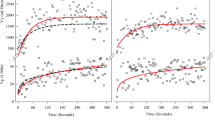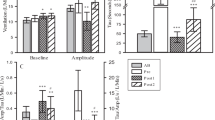Summary
The purpose of this study was to determine the effect of work rate increment on peak oxygen uptake (\(\dot VO_2\)peak) during wheelchair ergometry (WCE) in men with quadriplegia due to cervical spinal cord injuries (CSCI). Twenty-two non-ambulatory subjects (aged 20–38 years) with CSCI were divided into two groups based on wheelchair sports classification (n = 12 for IA group and n = 10 for IB/IC group). Subjects underwent three different, continuous graded exercise tests (spaced at least 1 week apart) on an electronically braked wheelchair ergometer. Following a 3-min warm-up, the work rate was increased 2, 4, or 6 W · min−1 for the IA group and 4, 6, or 8 W · min−1 for the IB/IC group. Ventilation and gas exchange were measured breath-by-breath with a computerized system. Repeated-measures ANOVA showed no significant difference among the three protocols for \(\dot VO_2\)peak in the IA group (P>0.05). The mean (SD) \(\dot VO_2\)peak values (ml · kg−1 · min−1) were 9.3 (2.4), 9.4 (3.2), and 8.4 (2.6) for the 2, 4, and 6 W · min−1 protocols, respectively. In contrast, the IB/IC group showed a significant difference among the protocols for \(\dot VO_2\)peak (P<0.05). The mean (SD) \(\dot VO_2\)peak values (ml · kg−1 · min−1) were 15.1 (4.0), 14.1 (4.4), and 12.7 (4.0) for the 4, 6, and 8 W · min−1 protocols, respectively. Post hoc analysis revealed a difference between the 4 and 8 W · min−1 protocols. Our results suggest that graded exercise testing of men with quadriplegia due to CSCI, using WCE, should employ work rate increments between 2 and 6 W · min−1 and that work rate increments of 8 W · min−1 or greater will result in an underestimate of \(\dot VO_2\)peak.
Similar content being viewed by others
References
American College of Sports Medicine (1986) Guidelines for exercise testing and prescription, 3rd edn. Lea and Febiger, Philadelphia
Bromley I (1981) Tetraplegia and paraplegia. A guide for physiotherapists. Churchill Livingstone, New York
Buchfuhrer MJ, Hansen JE, Robinson TE, Sue DY, Wasserman K, Whipp BJ (1983) Optimizing the exercise protocol for cardiopulmonary assessment. J Appl Physiol 55:558–564
Coutts KD, Rhodes EC, McKenzie DC (1983) Maximal exercise responses of tetraplegics and paraplegics. J Appl Physiol 55:479–482
Coutts KD, Rhodes EC, McKenzie DC (1985) Submaximal exercise responses of tetraplegics and paraplegics. J Appl Physiol 59:237–241
Davis JA, Whipp BJ, Lamarra N, Huntsman DJ, Frank MH, Wasserman K (1982) Effect of ramp slope on determinants of aerobic parameters from the ramp exercise test. Med Sci Sports Exerc 14:339–343
DiCarlo SE, Supp MD, Taylor HC (1983) Effect of arm ergometry training on physical work capacity of individuals with spinal cord injuries. Phys Ther 63:1104–1107
Figoni SF (1984) Spinal cord injury and maximal aerobic power. Am Correct Ther J 38:44–50
Gass GC, Camp EM (1979) Physiological characteristics of trained Australian paraplegic and tetraplegic subjects. Med Sci Sports Exerc 11:256–259
Golding LA, Horvat MA, Beutel-Horvat T, McConnell TJ (1986) A graded exercise test protocol for spinal cord injured individuals. J Cardiopul Rehabil 6:362–367
Hooker SP, Wells CL (1989) Effects of low- and moderate-intensity training in spinal cord-injured persons. Med Sci Sports Exerc 21:18–22
Hoppenfeld S (1976) Physical examination of the spine and extremities. Appleton-Century-Crofts, New York
Howley ET, Franks BD (1986) Health/fitness instructor's handbook. Human Kinetics, Champaign, Ill., p 55
Huszczuk A (1987) Energy measurement enabling apparatus. US patent number 4647036
Knutsson E, Lewenhaupt-Olsson E, Thorsen M (1973) Physical work capacity and physical conditioning in paraplegic patients. Paraplegia 11:205–216
Lasko-McCarthey P, Davis JA (1991) Protocol-dependency of \(\dot VO_{2max}\)during arm cycle ergometry in males with quadriplegia. Med Sci Sports Exerc (in press)
National Wheelchair Athletic Association (1988) National Wheelchair Athletic Association official rules. National Wheelchair Athletic Association, Indianapolis, Ind.
Rhodes EC, McKenzie DC, Coutts KD, Rogers AR (1981) A field test for the prediction of aerobic capacity in male paraplegics and quadriplegics. Can J Appl Sport Sci 6:182–186
Skrinar GS, Evans WJ, Ornstein LJ, Brown DA (1982) Glycogen utilization in wheelchair-dependent athletes. Int J Sports Med 3:215–219
Wicks JR, Lymburner K, Dinsdale SM, Jones NL (1977–1978) The use of multistage exercise testing with wheelchair ergometry and arm cranking in subjects with spinal cord lesions. Paraplegia 15:252–261
Wicks JR, Oldridge NB, Cameron BJ, Jones NL (1983) Arm cranking and wheelchair ergometry in elite spinal cord-injured athletes. Med Sci Sports Exerc 15:224–231
Author information
Authors and Affiliations
Rights and permissions
About this article
Cite this article
Lasko-McCarthey, P., Davis, J.A. Effect of work rate increment on peak oxygen uptake during wheelchair ergometry in men with quadriplegia. Eur J Appl Physiol 63, 349–353 (1991). https://doi.org/10.1007/BF00364461
Accepted:
Issue Date:
DOI: https://doi.org/10.1007/BF00364461




